#daumier’s law
Text
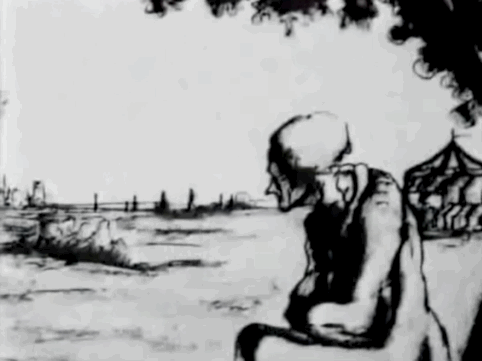


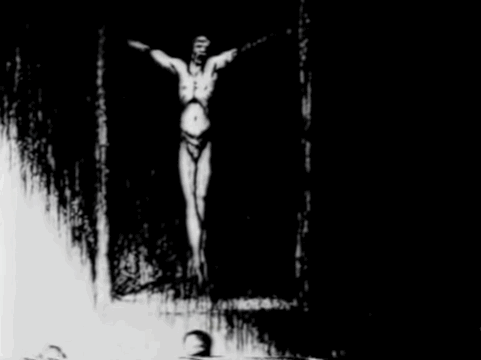
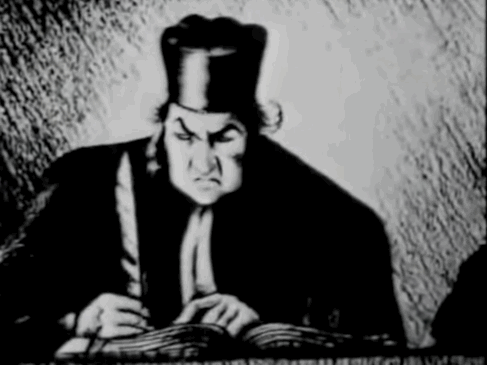





DAUMIER'S LAW
Paul: “I wanted to get into some minimalist music so I came to the studio and started trying to think of very simple pieces, based around the theme of injustice. .. I got intrigued by the idea of thinking ‘how few notes could I use, then?’ You start off thinking of just one note and then you embellish it a bit, trying to keep in the back of your mind to be as minimal as possible. And in the end I think I abondoned the idea of minimalism and just got into this slightly experimental music.”
Linda: “I got every book on Daumier and read all about his life and thought that it would be incredible to do a visual thing for Paul’s music. Daumier worked for a newspaper as a satirical cartoonist and went to prison a few times for his Art. A lot of his work was about injustice and it’s a theme that is so right for our times.”
Soon the two projects came together.
Geoff Dunbar: "Paul and Linda called and asked if I would like to make a film on Daumier and I said yes,”, “Before Rupert came along I had made a film on Toulouse-Lautrec so the Daumier idea was very exciting.”
“Paul did six pieces of music and they each had a title – Right, Wrong, Justice, Punishment, Payment, and Release. Then we pored through the works of Daumier, got everything that was available, and structured the story from the material. And where we had to link it we invented ‘in the style of’. We hung the story on one character, a man from one drawing by Daumier.”
The movie was premiered at the Cannes Film Festival in March 1992, and won the top prize at the British Academy Of Film And Television Arts in 1993. Paul & Linda are credited as co-writers and producers of the movie.
(Daumier's Law on YT)
(x)
#this man has done sooo many incredible things in his life and i just can’t comprehend how he did it all!!?#the music is AMAZING#imho#how does he do it??#how? HOW?#the animations are so good!! my eyes actually began to pee a lil bit#brilliant idea brilliant execution#linda#paul mccartney#honoré daumier#geoff dunbar#ian iachimoe#.•
65 notes
·
View notes
Text

EYE FOR AN EYE?
If any party maims another [person]: what was done shall be done in return - fracture for fracture, eye for eye, tooth for tooth. The injury inflicted on a human being shall be inflicted in return. - Lev 24:19-20
The Torah’s tit-for-tat law of personal injury seems, on its face, to be a recipe for disaster. As Gandhi quipped, “An eye for an eye will leave the whole world blind.” But this literal interpretation is based on a fundamental misunderstanding of Torah and Judaism. We don’t follow the Torah’s commandments based on the plain meaning of the text as understood by ourselves; we rely on the teachings of the great sages of the generations to understand what the Torah is actually saying.
The great medieval commentator Rashi (11th cent.) sums up millennia of interpretation to conclude that this line shouldn’t be understood literally. Rather, it means that financial compensation must be paid to the victim. If someone (God forbid) pokes out your eye, how will poking out that person's eye help you? Chizkuni (13th cent.) supports Rashi by pointing out that "in many instances it would be impossible to carry out the literal meaning of the text, and it would even be totally unfair, for instance, for a one-eyed person to have to lose one eye if he had gouged out the eye of a person who had two good eyes with which to see.” In order to exact justice, one must consult with a court of learned judges whose extensive knowledge of Jewish law enables them to put a monetary price on bodily injury.
Image: “The Three Judges” by Honore Victorin Daumier, c. 1859
5 notes
·
View notes
Text
Two by Jean Renoir
Boudu Saved From Drowning (Jean Renoir, 1932)
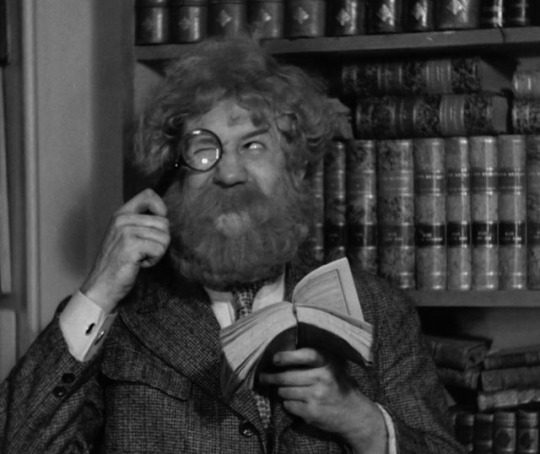
Michel Simon in Boudu Saved From Drowning
Cast: Michel Simon, Charles Granval, Marcelle Hainia, Sévérine Lerczinska, Jean Gehret, Max Dalban, Jean Dasté. Screenplay: Jean Renoir, Albert Valentin, based on a play by René Fauchois. Cinematography: Georges Asselin. Production design: Jean Castanier, Hugues Laurent. Film editing: Suzanne de Troye, Marguerite Renoir.
A Day in the Country (Jean Renoir, 1936)
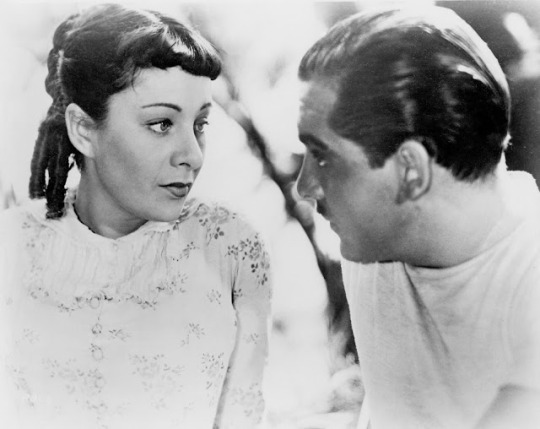
Sylvia Bataille and Georges D'Arnoux in A Day in the Country
Cast: Sylvia Bataille, Georges D'Arnoux, Jane Marken, André Gabriello, Jacques B. Brunius, Paul Temps, Gabrielle Fontan, Jean Renoir, Marguerite Renoir. Screenplay: Jean Renoir, based on a story by Guy de Maupassant. Cinematography: Claude Renoir. Film editing: Marinette Cadix, Marguerite Renoir Music: Joseph Kosma.
"Épater la bourgeoisie!" went the rallying cry of France's 19th-century poets like Baudelaire and Rimbaud, who styled themselves as "Decadents." But ever since Molière's M. Jourdain, the social-climbing bourgeois gentilhomme, was delighted to discover that he was speaking prose, French artists of whatever medium have delighted themselves in satirizing the manners and morals of the middle class, sometimes affectionately and sometimes savagely. On my living room wall I have two prints of cartoons done by Honoré Daumier in a series he called "Pastorales." Both show very solidly middle-class and middle-aged couples, presumably Parisians taking a day in the country. In one, the husband carries his large, copiously clad wife on his back as he fords a small stream that barely comes to his ankles. They have evidently been caught in a summer storm, for he is chiding her that such things are to be expected, even on the sunniest day. Meanwhile, she is urging him, "Ah, Jules, don't let the torrent sweep us away!" In the other, a similarly clad woman sits on the bank of a pond in which her husband, wearing his glasses and with his head wrapped in a handkerchief, has been taking a dip. "The water is delicious, Virginie," he says. "I assure you, you're making a mistake by not joining me." I was reminded of these prints while watching Jean Renoir's great short film -- it's only 40 minutes long, but every minute is golden -- A Day in the Country. In it, the Dufour family -- husband, wife, daughter, future son-in-law, and comically deaf grandmother -- find a country inn in a beautiful setting on their day away from the city. The mother and daughter immediately become targets for two young men, who manage to set off with them in their skiffs on the river, after diverting the other men by lending them fishing poles. The daughter, Henriette (Sylvia Bataille), goes with Henri (Georges D’Arnoux). When a storm comes up, they take shelter in the woods, where she yields to his advances. Years later, she returns to the same spot with her husband, Anatole (Paul Temps), an unromantic drip, and while he naps, she encounters Henri and recalls their brief encounter. The film is an exquisite mix of comedy and melancholy, the kind of subtle blending of tones Renoir is known for from his greatest films, Grand Illusion (1937) and The Rules of the Game (1939). A Day in the Country was in fact never finished -- weather interrupted the shooting and Renoir had to move on to another commitment -- but the existing footage was assembled ten years later under the supervision of the producer, Pierre Braunberger, with two explanatory intertitles, and it stands on its own as a masterwork. In sharp contrast to the affectionately amused treatment of the bourgeoisie in A Day in the Country, Boudu Saved From Drowning is a raucous free-for-all centered on the great eccentric Michel Simon in the title role. Boudu is a tramp, a shaggy monster, who after his dog runs away decides to drown himself in the Seine. But he is rescued by Édouard Lestingois (Charles Granval), a bookseller, who takes him into his home. Boudu proceeds to trash the place and seduce both Mme. Lestingois (Marcelle Hainia) and the housemaid (Sévérine Lerczinska), who is also Lestingois' mistress. Simon's performance pulls out all the stops in one of the greatest comic tours de force in film history. If you want to see what épater la bourgeoisie really means, just watch Boudu.
#Boudu Saved From Drowning#A Day in the Country#Jean Renoir#Michel Simon#Sylvia Bataille#Georges D'Arnoux
1 note
·
View note
Text
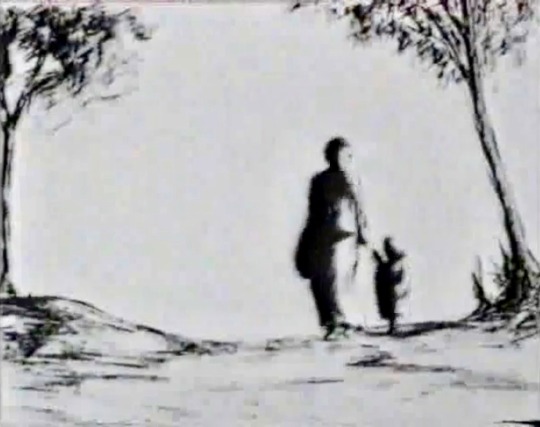
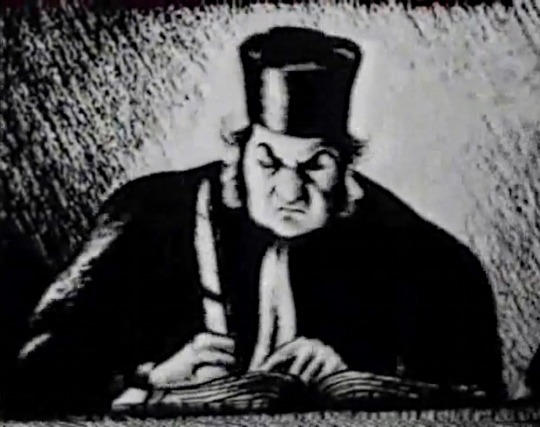
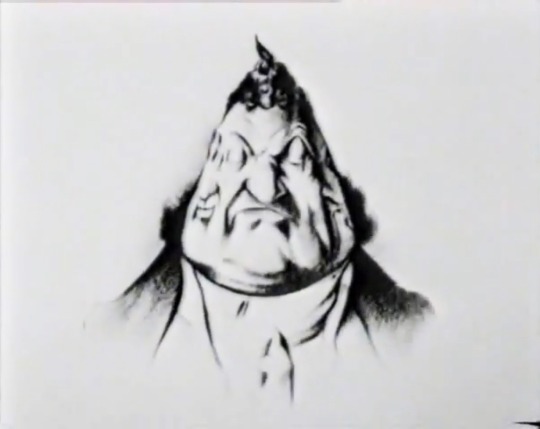


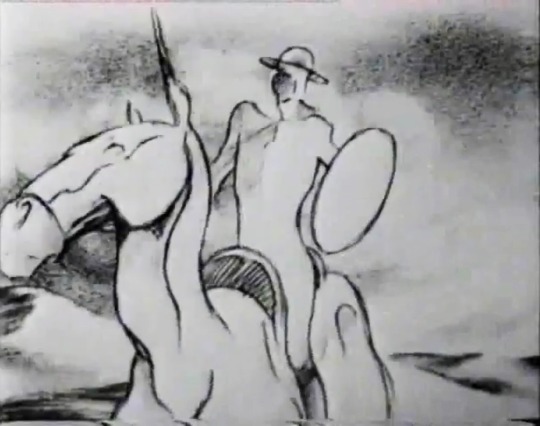
Paul McCartney’s animated short, DAUMIER’S LAW (1992). Based on the drawings of 19th-century French caricaturist Honoré Daumier, it was animated by Geoff Dunbar, with music by Paul himself.
#animation#animated#shorts#paul mccartney#honoré daumier#daumier#daumier’s law#films#images#geoff dunbar
156 notes
·
View notes
Text
On a Bombastic Lawyer
Martial, Epigrams VI.19
It’s not about violence, slaughter, or poison,
But about three goats that I’ve gone to law:
My neighbor made off with them, I complain.
It's this that the judge requires to be proved –
But you go on with mighty voice
And wild hand-gestures all about Cannae,
The war against King Mithridates,
The broken oaths of the Punic madness,
And Sullas, and Mariuses, and Mucius Scaevolas…
Now speak, Postumus, about my three goats!
Non de ui neque caede nec ueneno,
sed lis est mihi de tribus capellis:
uicini queror has abesse furto.
Hoc iudex sibi postulat probari:
tu Cannas Mithridaticumque bellum
et periuria Punici furoris
et Sullas Mariosque Muciosque
magna uoce sonas manuque tota.
Iam dic, Postume, de tribus capellis.

Two Lawyers Conversing, Honoré Daumier (1808-1879)
#classics#tagamemnon#Latin#Latin language#lingua latina#poem#poetry#translation#poetry in translation#Latin translation#Martial#Ancient Rome#Roman Empire#epigram#satire#satirical epigram#hendecasyllabics#Honore Daumier
42 notes
·
View notes
Text

“If the bringing of children into the world is today an economic burden, it is because the social system is inadequate; and not because God’s law is wrong. Therefore the State should remove the causes of that burden. The human must not be limited and controlled to fit the economic, but the economic must be expanded to fit the human.”
~ Fulton J. Sheen
[Wagon of the Third Class, 1862 - Honore Daumier]
• Fulton John Sheen (born Peter John Sheen, May 8, 1895 – December 9, 1979) was an American archbishop of the Roman Catholic Church known for his preaching and especially his work on radio and television. In the 1950s, his television show called "Life Is Worth Living" made him a household name. More: https://fultonsheen.com
• Honoré Daumier's career was one of the most unusual in the history of nineteenth-century art. Famous in his time as France's best-known caricaturist, he remained unrecognized in his actual stature--as one of the period's most profoundly original and wide-ranging realists. Even today, his essential quality may not be fully understood; the marvels of his pictorial inventions are half-hidden in the profusion of his enormous lithographic work, the sharp truths of his observation overshadowed by his comic genius and penchant for monumental stylization. Honoré Balzac's remark, "There is a lot of Michelangelo in that fellow," was perceptive, though probably made in a spirit of friendly condescension. More: https://www.nga.gov/collection/artist-info.1209.html
#honoredaumier #revolutionoftenderness
#honore daumier#fulton sheen#children#economy#social system#social injustice#social justice#justice#economics#saints
2 notes
·
View notes
Photo

Rue Transnonain, le 15 April, 1834, Honoré Daumier, 1834, Cleveland Museum of Art: Prints
Although it supported the French middle class, the government of Louis-Philippe (1773–1850) oppressed workers. The rebellion of the silk weavers of Lyon, who toiled 18 hours a day for a pittance, touched off a sympathetic revolt in Paris. During the uprising, sniper fire directed toward government troops emanated from a house on the Rue Transnonain. In retaliation, the soldiers indiscriminately massacred residents, including old men, women, and children. In this haunting image, Daumier focused attention on the human suffering and loss of life, emphasizing the innocence of the victims and the violence of their deaths. Between 1830 and 1835 censorship laws had been suspended, allowing Charles Philipon (1806–1862) to publish a number of periodicals like L'Association Mensuelle, where Rue Transnonain appeared. Daumier, one of the most accomplished and prolific lithographers of the 19th century, often provided caricatures criticizing contemporary political abuses or satirizing French society.
Size: Sheet: 36.5 x 55 cm (14 3/8 x 21 5/8 in.); Image: 28.6 x 44 cm (11 1/4 x 17 5/16 in.)
Medium: lithograph
https://clevelandart.org/art/1924.809
35 notes
·
View notes
Text
Week 7, Ch 23 &24
I find it appropriate that realism is the topic of focus when reading about the nineteenth century because that is a time where people are beginning to point out the realities of life instead of the luxuries. This is a time where artists are connecting people and art with nature and incorporating real life experiences into their own artwork.
Gustave Courbet was an artist that stood out to me when reading chapter twenty-three of A History of Western Art because he believed that realism was created best by those who made art based off their own experiences. I connected to this because my personal favorite art to create comes from my own experiences in traveling. In my free time, I enjoy painting things in relation to the ocean. Some of my most enjoyable memories come from spending time by the sea, which inspires me to paint portraits of beach scenery and creatures of the ocean. I connect with these moments so much that all the tattoos I have thus far are of ocean theme. I agree with Courbet when he says that the realest and most authentic artworks in realism come from those who have experienced it themselves (page 418).
Honore Daumier’s, Louis Philippe as Gargantua, was a great example of the mockery of artists to political figures in the nineteenth century. This print of the prince carelessly eating all the people in poverty’s goods showed what was happening in political society and how it was affecting people. Although this was an exaggeration, Daumier was sent to jail for this print and a new law was proposed so that no illustrations were allowed in the press, only words instead. I like this story because it shows the power of corrupt politicians and how artists were standing up for civilians with no voice even though there would be consequences in the end.
Chapter twenty-three also discusses the development of photography. When noticing some of the first stages of photography, it is so cool to see the monumental improvement to where we are today with capturing photos. Photography is something I have grown to enjoy as a personal hobby, and I almost always take my DSLR camera wherever I go. I am grateful for the development of photography and appreciate the process and knowledge it took to get to where cameras are today.
In chapter twenty-four, it states that unlike realism in the 19th century, impressionism rarely gave a focus to political views. This is interesting in the fact that based off different styles of artwork, the artists seemed to have very different standpoints. Before reading chapter 24, I felt I could relate to realism artists more, but afterwards I have noticed that impressionism art focused on the effects of light in nature and weather occurrences, which is what I prefer as a better viewpoint myself.
Claude Monet’s, Bassin des Nympheas, stood out to me on page 440 because it has so much detail in every brushstroke. The way the vibrant colors reflect a deep green onto the water to show the stillness of the water is not only clever, but visually appealing as well. I like that this painting was inspired by his own water garden, similar to how Gustave Courbet used his own experiences to create realism artwork in chapter 23.
Chapters 23 and 24 discussed realism and impressionism in the nineteenth century and how the development of art and photography in real world situations were affective in the portrayal of politicians versus society. Nature and lighting were also a major part in the creation of realism and impressionism artworks.
*All references to artwork and artists come from chapters 23 and 24 of Laurie Schneider Adams, A History of Western Art, 5th edition.
7 notes
·
View notes
Text
21.5.21
War and Revolution pt.3 Notes ( This was a really long lecture :0 so long notes)
Sir Isaac Newton: the best consequence of the enlightenment, solar system/motion
Lavoisier- chemist
Charles Darwin- evolution/origin of species -vilified by the church/thought Industrial Revolution (1750-1900) -The enlightenment: logic over belief ( dark ages), science, mechanization of labour, migration to cities, demand for products, low farm wages.
-Utilitarianism: theories that promote action to maximise happiness and well-being for the majority of the population
-1764-74:Spinning Jenny, water frame, steam engine, spinning mule. -1799- work unions illegalized.
-1811-13 Luddite Rebellion- going back to something that ceases to exist.
-1833- first small regulations of child labour.
-1834-poor law.
-1848- The Communist Manifesto published by Marx and Engels -1880-School compulsory until 10.
-British Colonisation: Raw Materials/ Market.NZ heavily explored as a place of resource.
-Childhood/adolescence is a Western construct because they can afford to extend their childhood (interesting thought!!)
Social Realism
-Courbet, The Stone Breakers, 1845
-Daumier, The third-class carriage,1862
-Hermans- Dawn 1875
Romanticism
-Delacroix- The Death of Sardanapalus- Romantic escapism
-Turner- Rain, Steam and Speed, 1844
-Monet- La Gare..Lazone, 1877- atmospheric effect of steam.
-invention of paint tube- impressionism/interacting with nature/en Plein air, change of subject matter
-Renoir portrait of Monet 1875
-Monet/Renoir La Grenouillere- recording light on objects
-Manet- Luncheon on the Grass, Olympia 1863
-Whistler- Salon des refuses
-Cabanel, Birth of Venus, wins gold
-First Impressionist Exhibition in 1874
-Balloon photograph- Nadar.Landscapes from a different perspective
-Bernhadht
-George Sand
-Duchenne, Displeasure/ Terror 1854
-Toulouse Lautrec 1864-1901- beginnings of Banksy type, portraits of brothels.
-Lautrec, portrait of Van Gogh
-Degas,
-Gertrude Alice
-Ezra Pound
0 notes
Link
The art of satire | Art & Culture “You can’t make up anything anymore. The world itself is a satire. All you’re doing is recording it.” — Art Buchwald Throughout history, satirists have reflected on the society that surrounds them. To be a satirist is to have a moral calling: to highlight the hypocrisies of a time. Works of satirical artists like Hogarth, Honore Daumier and Francico Goya have lived in history. The Georgian era marked the golden age for caricature in England. Through their work, artists have been illuminating and ridiculing the absurdities and follies of human beings. Using exaggeration as a tool, they have addressed pressing problems affecting their societies, including subjects that are usually taboo. The exhibition titled Diasporic Rhizome is a joint venture of satirical expression and clever mockery on display virtually. A project of 21 South Asian artists, it delves into topics like arrest of artists, journalist, writers and social workers; false accusations; women’s suffering; oppression; colonialism; killing of Muslims with the rise of Islamophobia; political unrest and racism in America that focuses exclusively on the voices of women of colour. The works are cryptic, surreal, disturbing and provocative. Sofia Karim’s Tribune Bagh is a stark satire against injustice and inequality. She and some fellow artists, poets and thinkers had organised Turbine Bagh, a protest at the Turbine Hall of Tate Modern Museum, London, as a gesture of solidarity by the diaspora. Tribune Bagh is a reference to Shaheen Bagh, the women-led protest in New Delhi that was the epicentre of the resistance prior to Covid-19 lockdown. The global protest is designed in the form of “samosa packets to show solidarity with Shaheen Bagh protest in India. The work highlights the anti-Muslim citizenship laws in Delhi, human rights situation (across India and Bangladesh), imprisoned artists, fascism and authoritarianism. A packet titled Release Abdul Kalam was a satire against the arrest of the photographer who photographed the refugees of Bashan Char island. The packet shows a photograph taken by Kalam, himself. In his collaborative project with Tariq Ali, Amin Rehman uses word art installation as his mode of expression. His work is a commentary on the effect of aggressive globalisation and decolonisation. The artist writes in his exhibition catalogue: “The installation is deep-rooted in rhizomatic thoughts and diasporas’ identity that serves as the pictorial content and interests in the phraseology of aggressive globalisation, colonisation and decolonisation. The installation challenges us to decipher the text layers through a shared interactional technique, like the palimpsest technique and plays with the cultural meaning embedded in superimposed or layered meaning typography. The work is suggestive of graphic and informational strategies reused in American pop art in the 1960s.” Rehman’s word art is a commentary on what appears to be truth on the surface, projected by modern media and lobbyists in global politics and social surroundings. The viewer is compelled to find the message hidden in the layers of his word installation. He provokes critical thinking and paints a picture through words. In an email interview, Amin says: “The pandemic and the necessary safety protocols have heavily affected the art community as it has taken away a large component of being able to show work in physical spaces. On the other hand, online discussions are more accessible… On a personal note, seeing the lives of others going through hard time, rising rates of poverty and death is mentally hurting.” Amin resides in Toronto. His upcoming exhibition The Bleeding Borders will be held at Art Gallery of Grande Prairie, Alberta, in the fall of 2021. Mapping Memory by Saba Karim and Shaheen Ahmad is about solidarity amongst global artists. Both are hopeful that artists will work towards more sustainable online collaborations during the pandemic. Through their work, they are “understanding transnational movements, migrations and friendship of artists in the three regions of Bangladesh, Pakistan and the UK”. Anamika Singh is an artist and designer based in New York. Her installation addresses the demolition of Osama bin Laden’s compound in Abbottabad. She writes in her catalogue: “As our landscapes are populated by military monuments, militarised urban infrastructure and networks of surveillance. How are our personal and shared histories folding themselves within dense entanglements of violent legacies? What grows in the voids left by methodical demolitions, site-less shrines and continually mutating and mediated memories?” Asma Kazmi’s Building the City of Exiles refers to the incident when a construction crane fell down on pilgrims in Makkah. She says humans around the globe are living under the shadow of idyllic skyscrapers, amongst health crises and inequality. “Uban space seems beholden to the aspirations of builders and planners who erect skyscrapers at alarming rates. Who and what is marginalised in this process? What is the toll on the environment?” Nitin Mukul, born in Lawrence, Massachusetts, is based in Queens, New York City. Her installation titled Blue Lake, With Live Performance can be experienced as a durational event. He begins his work with layers of paints placed in sheets of ice, freezing each layer of acrylic and oil so that they accumulate layers of color and texture. Placing the frozen mass outdoors, he allows it to melt according to weather conditions, filming the process with a tight zoom. Maryam Hina Hussain, born and raised in Karachi, now lives in London. She uses materials like textiles for her work. She enjoys using pigments to create the images. Spandita Malik, a New York-based artist from India, criticises the current global socio-political state of affairs with an emphasis on women’s rights and gendered violence. Her Nari comprises embroidered photographic portraits made in collaboration with women artisans from India. Her work documents the sacrifices of women confined in the so-called “safe spaces” of their homes , working day and night to embroider the cloth. Melissa Joseph’s Pocket Brass satirises the ‘pockets’ – metaphorically political spaces. Her work, a collection of animations and videos, focuses on her own experiences and imagination as a second generation Indian American. Pockets symbolise secrets, ownership, privacy and hidden sentiments. Once stolen, they lose value. Mara Ahmad, a US-based Pakistani artist, is interested in dialogue through physical and psychological borders. Showcasing the film titled: Le Mot Juste [Part One], she focuses on the languages she has learned and the concreteness of the syntaxes. Being able to speak three languages, she enjoys connecting the borders. Jaret Vadera’s Ascending to Outer Space to Find Another Race is influenced by Rorchtests, FMRI’s, info graphics kinetic science, science fiction, Buddhist philosophy and study of the impossible. It explores parallels between the internet and neural networks – search engines and memory. The viewer has to examine and experience the work in order to interactively manufacture the meaning. Diasporic Rhizome will remain on virtual display till May 15 at www.diasporicrhizome.com. The writer is an artist and educationist based in Lahore https://timespakistan.com/the-art-of-satire-art-culture/16433/?wpwautoposter=1618714827
0 notes
Photo

A Criminal Case - Honoré Daumier, 1865
Watercolor and gouache with pen, brown ink and black chalk, 38.4 × 32.5 cm (15 1/8 × 12 13/16 in.)
An astute observer of human nature and an often biting satirist, Honoré Daumier here masterfully employed watercolor to illustrate the foibles of the French judicial system. Poverty forced Daumier to begin work at an early age; he once took a job as a messenger for the city's law courts, where he was exposed to the complexities and inequities of the legal system. The strong, dramatic diagonal of this composition focuses the viewer on the accused murderer. He leans over the dock to consult with his lawyer, who clearly controls the exchange, raising his right hand and seizing a sheaf of papers for reference. In contrast to the well-groomed and elegant lawyer, the criminal is wild-eyed and coarse. In the background a guard stands stiffly, oblivious to the exchange before him. In the gray courtroom, the empty space behind the guard suggests an air of anxiousness and uncertainty. [x]
7 notes
·
View notes
Photo

Antique Original Artwork – “Protectors of the Law” – Daumier EUR 199.12End Date: Tuesday May-7-2019 1:43:17 ISTBuy It Now for only: EUR 199.12Buy It Now | Add to watch list Powered by WPeMatico
0 notes
Text
Unpacking my Library • Eloi Valat • The Paris Commune • 2019







I have just found a lovely book, with illustrations by Eloi Valat. It is a book about the women of the Paris Commune (1871). The history of the Commune is well known, and comprehensively documented on the internet. Indeed, Valat has produced four books that re-visit the mythology of the Paris Commune in all its brutal, tragic and romantic beauty...of doomed idealism and barbaric violence.
The four books, with illustrations by Valat, relating to the popular history of the Commune are
Le Journal de la Commune (2008)
L’enterrement de Jules Valet (2011)
La Semaine Senglante (2013)
Louises, les femmes de la Commune (2019)
Eloi Valat is not a familiar name beyond France...I think he deserves to much better known.
I have posted before about illustrated books from France... and their special role in the promotion of the national narrative...most of the books I like are about 100 years old; so I am thrilled to find something exciting from the present.

Valat’s books present the story in illustrated form...not quite as comic books, but in the grand tradition of imagerie d’Epinal, Caran d’Ache, Otto Dix, and George Grosz. There’s also something cinematic, at least nodding toward Sergio Leone, in the way that the figures and space are configured...Just like the title sequence of Once upon a Time in America, or the shoot-out climax of The Good, the Bad, and the Ugly...
Here’s a post from my railway themed blog
https://bagdcontext.myblog.arts.ac.uk/2011/08/18/once-upon-a-train-track-in-the-west/
There’s also a nod to the visual style of Daumier’s satirical sculptures in Valat’s style of drawing.
I especially like the flat-colour and ligne-claire (black line) drawing style.
Valat’s images, typically presented across a double page-spread combine an epic sense of space with dramatic economy. That combination of sophistication and simplicity is very hard to get right.
Perfect.
The Paris Commune was a short-lived attempt at a popular and autonomous form of democratic self-government...the idealistic experiment was brutally suppressed by the forces of law-and-order. The basic narrative of the Commune is best known, nowadays, from the story-line of Les Miserables...although that particular rebellion was the June Rebellion of 1832.
Interestingly, the earlier popular uprisings in Paris, including that of 1848, provoked the demolition of the ancient city and its replacement with an urbanism of wide boulevards, specifically elaborated so as to provide site-lines of panoptic control and gun-fire. The successful suppression of the Commune provided a complete vindication of Haussmann’s plans...
Many photographs attest to the brutality of fighting, on both sides, in this struggle.
Notwithstanding the bloody fighting and the martyrdom of many Communards, the Commune is now recognised as an important staging post in the development of popular autonomy and self-government in modern democratic systems.
Here’s a page-spread from the book, to give you an idea of how dramatic and dynamic it looks...terrific

0 notes
Text
George Bellows, "Club Night," 1907

"George Bellows’s paintings devoted to boxing were among the most popular pictures he produced during his lifetime and remain so today. Executed in August and September 1907, Club Night is the first of three similar boxing subjects that Bellows painted early in his career, from 1907 to 1909. Club Night represents a fight at an athletic club in New York City owned by Tom Sharkey, a former heavyweight champion. The enactment of the Lewis Law in 1900 prohibited boxing in New York State, but Sharkey and others circumvented the law by staging bouts in their private 'clubs,' where attendees paid membership dues instead of admission fees to a particular fight, allowing them to legally gamble on matches. The public’s generally positive response to this controversial subject reflected an ambivalent attitude toward the sport. Some regarded boxing as a savage, brutal pastime, but many thought it a natural manifestation of masculinity. When criticized for not accurately representing certain technical aspects of the sport, Bellows responded, 'I don’t know anything about boxing. I’m just painting two men trying to kill each other.' In addition to precedents in the work of the American realist Thomas Eakins, Bellows’s boxing paintings paid homage to the European painters recommended to him by his teacher and mentor, Robert Henri. Whereas Bellows later drew inspiration from the rich black tonalities and biting satire of the 17th-century Spanish master Francisco de Goya for Both Members of This Club, the smoky, atmospheric haze that envelops the scene in Club Night and Bellows’s painterly technique and rendering of the crowd owes much to the great 19th-century French painter and caricaturist, Honoré Daumier."
National Gallery of Art

Preliminaries of the Big Bout, 1916, lithograph
"George Bellows is of the Ashcan School and the school of hard knocks: both institutions are rooted in realism. Bellows' interest in boxing coincided with the rise of other realists, though of different dimensions. The author Jack London and president Teddy Roosevelt were ascendent, immensely popular figures with turn of the century, hardscrabble Americans. At the time London was writing, Roosevelt was bullying, and Bellows was painting, the sport of boxing was drawing immense crowds across the country. There is a raw, primal intensity to Bellows' paintings of boxing matches. With slashing brushstrokes of thickly applied paint, he is able to capture the animal violence and muscular brutality of man. The energy and intensity of the bout is captured in both the clashing pugilists and in the frenzied crowds surrounding the ring. 'The atmosphere around the fighters is a lot more immoral than the fighters themselves,' Bellows once remarked. In 'Club Night' above, the ring is illuminated by an overhead lamp, keeping the focus on the violent ballet in the center. ..."
The Art of Boxing: George Bellows

The Knock Out, 1907, ink & pastel on paper
NGA: The Art of Boxing—George Bellows at the National Gallery of Art, Washington (Video)
6 notes
·
View notes
Text

“If the bringing of children into the world is today an economic burden, it is because the social system is inadequate; and not because God’s law is wrong. Therefore the State should remove the causes of that burden. The human must not be limited and controlled to fit the economic, but the economic must be expanded to fit the human.”
~ Fulton J. Sheen
[Wagon of the Third Class, 1862 - Honore Daumier]
#honoredaumier #revolutionoftenderness #fultonsheen #economics #justice #socialjustice #catholicsocialteaching #bomb #truth #life #poverty #human #flourishing
0 notes
Text
illustrator & picture book author Steven Salerno (career info)
OVERVIEW
New York City based illustrator, children’s book author, and character designer Steven Salerno creates sophisticated, eclectic illustrations for a wide range of editorial and advertising clients, the stylization of his art images flexing between graphically simple, to more realistic, richly textured images depending on the nature of each project. Over his long independent graphics career he has created thousands of published illustrations for a list of 500+ prominent clients for use in print & web advertising, magazines, newspapers, product packaging, corporate publications, and retail graphics.
Steven has also illustrated 30 popular picture books for children.
Originally from Vermont, he is an honors graduate of the Illustration Department at Parsons School of Design (New York City) in 1979, where he studied art history, printmaking, animation, and illustration under top industry professionals, including the famed author/illustrator Maurice Sendak, creator of the ground breaking picture book, Where the Wild Things Are.
Although Steven is now primarily engaged with illustrating/writing picture books for children, he still also creates illustrations for client projects in print & web advertising, magazines, newspapers, corporate publications, product packaging, and retail graphics, etc…
List of prominent clients have included: The Wall Street Journal, The New Yorker, American Express, Simon & Schuster, Disney, IBM, Esquire, United Airlines, Newsweek, Lincoln Center, MTV, Ogilvy & Mather Worldwide, Curious Pictures, Random House, The New York Times, United Postal Service, McDonald’s, Apple, Time Warner, Felissimo, Scholastic, Lord & Taylor, Baltimore Symphony Orchestra, Columbia University, Random House, Microsoft/SLATE, GQ, Gourmet, The Atlantic Monthly, and hundreds more…
view Steven Salerno’s illustration client list
Steven’s advertising and editorial illustrations have been recognized for excellence by: Communication Arts, Print, Society for News Design, Society of Publication Designers, and The Art Director's Club.
He has been a guest speaker at Parsons School of Design (NYC), School of Visual Arts (NYC), as well as at NYC Public Schools, and at town/city libraries. Steven’s illustration art has been exhibited in solo and group shows in New York City, Seattle, Louisville KY, and Tokyo, as well as in traveling group shows to numerous US cities with The Society of Illustrators, and with Pratt Institute.
PICTURE BOOKS
Since 2000 Steven has illustrated 30 popular picture books for children (fiction and non-fiction.) Steven is both the author & illustrator of 5 of these titles. His whimsical illustrations of expressive, memorable characters move and define the stories. And for the non-fiction historical picture book titles his richly composed illustrative scenes successfully capture the look and spirit of the people and places of the era.
Some of Steven's picture book titles have been translated into Chinese, German, Korean, Japanese, Arabic, and Spanish.
Steven’s picture books have been recognized for their excellence by: The Society of Illustrators (NYC), and the Junior Library Guild. They have received industry starred reviews from Publishers Weekly, Kirkus Reviews, School Library Journal, Children's Literature, The New York Times Review of Books, and have been displayed by the Society of Illustrators (NYC) in their annual exhibition and children's picture book art exhibition.
list of Steven’s 30 published picture books
CURRENT PICTURE BOOK PROJECT Steven is now working on the illustrations for, Gizmos, Gadgets and Guitars -The Story of Leo Fender -written by Michael Mahin and illustrated by Steven Salerno (non-fiction, published by MacMIllan/Christy Ottaviano Books, scheduled release in 2021) The true story of Leo Fender, a California kid in the 1920’s who loved tinkering with radios and electronics which lead to opening his own radio and electronics repair shop in the 1930’s where he also began repairing electrified acoustic guitars and amplifiers. This all lead him to create his own version of a thin solid-body electric guitar in the late 1940’s named the Fender Esquire which was renamed the Fender Telecaster in 1950, the most iconic mass produced electric guitars in Rock n Roll history.
RECENT PICTURE BOOK RELEASES The Crayon Man -The True Story of the Invention of Crayola Crayons -written by Natascha Biebow & illustrated by Steven Salerno (non-fiction, published by Houghton Mifflin Harcourt 2019) The true story of Edwin Binney, inventor in 1903 of the first color crayons for kids, Crayola Crayons. view illustrations for The Crayon Man
view how the illustrations for The Crayon Man were created
Wild Horse Annie -Friend of the Mustangs -written by Tracey Fern & illustrated by Steven Salerno (non-fiction, published by Farrar Straus Giroux 2019) The true story of horse lover and activist Velma Bronn Johnston (AKA Wild Horse Annie) who was the driving force behind Federal Laws in the 1970’s protecting wild horses and burros on public lands. view illustrations for Wild Horse Annie
ARTISTIC INFLUENCES Steven’s artistic influences come from studying his favorite artists in the fine art world as well as in the illustrative arts. These influences are subtle yet can be seen in his own illustration work. He never emulated any one specific artist but over time visual elements from many different artists integrated their way into his own way of creating characters and illustrative images. Artists such as Windsor McKay, Honore Daumier, Francisco Goya, Ludwig Bemelmans, Henri Toulouse-Lautrec, Gustaf Tenggren, and many others…
DESIGN SCHOOL AND EARLY ILLUSTRATION CAREER The week after graduating from Parsons School of Design in New York City in 1979 (now named, Parsons New School for Design) Steven began his freelance illustration career with assignments from New York magazine, The New York Times, and other prominent publications. However, building up his freelance client base was a slow process. (This was the pre-digital era: no personal computers, no internet, no cell phones, not even fax machines yet. Illustrators had to meet with art directors in person to show their illustration samples in a portfolio book.) So Steven also got a job at one of the top animation studios in Manhattan at the time, Perpetual Motion Pictures -a producer of animated TV commercials and specials.
His first position there was at the lowly rank of cleaning the transparent celluloid sheets (cels) so that they could be reused. Then he ran the xerography transfer machine which copied the pencil line art drawn on paper and transferred it onto cels -which converted the pencil line into a black ink line. Next Steven was bumped up to the position of assistant animator where he had the important task of drawing all the “in-between” drawings of the key character poses that were drawn by the senior animators. During his lunch hour breaks Steven would run out with his illustration portfolio to meet with magazine and advertising agency art directors -and whenever he got a freelance illustration assignment he would create the illustrations during the night to meet the deadlines.
After about a year of working at the animation studio his freelance assignments became steady enough for him to quit, allowing full attention to his growing freelance illustration career.
Steven’s highest profile client in those early years as an illustrator was The New York Times, working for various sections of the paper but most often (from 1980 to about 1983) he created social/political illustrations for their Letters to the Editor Page and Op Ed Page. Note: some of Steven’s drawings for The New York Times during that time period were included in the recent book, “All the Art That’s Fit to Print (And Some That Wasn’t) Inside The New York Times Op/Ed Page”. -written by Jerelle Kraus, the former NY Times art director of the Op/Ed Page… the art director that Steven had created many drawings for.
GOLF ART
Steven worked as a freelancer creating illustrations predominantly for magazines, news-papers, and also for some advertising agencies from 1979 through 1986… then, for a brief 3 year period from 1987 through 1990, he stepped away from his illustration career to work in the golf business! (Note: Steven had played golf beginning as a young boy, learning the game from his father (a low handicap amateur player and 20 time Club Champion) and when Steven was age 17 he won his home state’s Junior Amateur Championship. So he always had a keen interest in golf. When he went to New York City to attend design school he stopped playing golf… but his affinity with the game of golf was always brewing, so after having moved out of NYC in 1986 to live in Connecticut he took a chance and resurrected his golf game and accepted a position as an Assistant Golf Professional at The Yale Golf Club in New Haven, Connecticut for two years, then for a year at Racebrook Country Club also in Connecticut. During this period Steven an apprentice in the PGA.
In 1990 Steven decided to leave the golf business just as abruptly as he had entered it, returning to his natural career as a full-time freelance illustrator again, creating illustrations for editorial publications and advertising. But his love for the game of golf never abated, so he simply added creating golf art images to his artistic repertoire. Subsequently, Steven’s golf art and golf graphics have appeared in Golf Digest, GOLF magazine, Golf World, and LINKS magazine, and his portraits of top PGA Tour players have appeared on pgatour.com. His limited edition, signed golf art prints are in private collections in the USA and Europe.
view some of Steven Salerno’s current golf related drawings & graphics
STYLE CHANGE In 1991 after the short sidetrack into the golf business Steven returned to his career of creating editorial & advertising illustrations and he also took it as a perfect opportunity to revamp the entire approach to his illustration style… and decidedly began creating his illustrations in a much more whimsical, lighter and more colorful manner compared to his darker and more serious illustrations from the early period in his illustration career from 1979 to 1987.
This lighter more whimsical approach Steven took in creating his illustrations created even more interest from both editorial and especially with advertising clients… and combined with signing up with one of the top NYC illustration representative firms, Lindgren & Smith Inc. in 1992 Steven’s range of clients expanded even further. (Note: Steven was represented by Lindgren & Smith Inc. from 1992 through 2004.)
FOOD & BEVERAGE During this time period from 1992 through 2004 when Steven’s illustration stying was decidedly light and whimsical, he was frequently commissioned to create a great number of food and beverage related illustrations for magazines, advertising, cook books, and even for fast food retail graphics… Client’s such as McDonald’s, World Wrapps, Fleming’s Steakhouses, Carrabas Italian Grill, El Paso Chili Company, Bon Appetit, Saveur, Kraft General Foods, Gourmet, Healthy Choice, Williams-Sonoma, Food & Wine, Coca Cola, Weight Watchers, and many more…
ILLUSTRATING PICTURE BOOKS…
When Steven first graduated from Parsons School of Design back in 1979 he was especially interested in creating illustrations for picture books, but his initial numerous presentations of his illustration portfolio to art directors and editors at publishing houses early in his career never elicited any picture book contract offers. Steven’s intense schedule of creating illustrations for editorial and advertising clients kept him busy -and the time flew by! Periodically over the ensuing years he would again attempt to obtain picture book projects to illustrate, but none materialized. Then in 1998 Steven expressed his strong desire to illustrate picture books to one of his illustration agents at the time Lindgren & Smith Inc. -so they put out industry promotional ads showcasing Steven’s illustrative images appropriate for the picture book genre, which quickly elicited picture book project offers from publishers. In 1999 Steven was first offered to illustrate a picture book, the Bill Martin Jr. story, Chicken Chuck -which was published by Winslow Press in 2000. This was followed by an offer to illustrate the picture book story written by famed author Margaret Wise Brown entitled, The Dirty Little Boy. Margaret Wise Brown is probably most well known for writing the children’s book classic, Goodnight Moon. (Note: Her story The Dirty Little Boy was originally titled, How the Animals Take a Bath -first published in 1939 in a magazine. The estate of Margaret Wise Brown allowed the publisher to rename the story “The Dirty Little Boy” for the 2001 version Steven illustrated, published by Winslow Press.)
Next, Steven was finally able to illustrate one of his own picture book stories, Little Tumbo -which was released in 2003 by Marshall Cavendish Children’s Books… His picture book career was off and running! Beginning with his first picture book released in 2000 and through 2019 Steven has illustrated 30 picture books for both fiction & non-fiction stories (with 5 of these titles as author & illustrator). Click link below to see all of Steven’s picture books published through 2019:
list of Steven’s 30 published picture books
STYLE CHANGE (AGAIN) In 2004 after many years Steven parted ways with his rep firm of 12 years, Lindgren & Smith, Inc. to again represent himself, just as he had at the start of his illustration career. Since 2004 he has focussed on writing his own picture book stories and continued to illustrate many more picture books… Steven also continued to create illustrations for advertising and editorial clients.
In about 2004 he slowly began to also include more realistic, richly textured illustration images back into his portfolios, sort of a new spin on his own style from very early in his career. This emerging more realistic style was further reinforced in 2010 when he began creating golf art images in a similar manner (for sale as limited edition prints), and also in 2012 when he first began illustrating non-fiction historical picture books, such as Brothers At Bat, and The Fantastic Ferris Wheel, all created in a more realistic manner compared to the simple, whimsical look of the illustrations created in the 1990’s as well as for many of his illustrated fiction picture books.
So currently Steven’s illustration range still includes images created in a simple, graphic style, to other images that are more realistic and richly textured, with some with having a retro feel.
PORTRAITS Steven also creates portraits and during his career has completed many assignments to create likenesses or caricatures of politicians, celebrities, and other famous people from history…
view the portraits portfolio section on Steven’s web site
ALIEN CREATURES One of the interesting portfolio sections you will see on Steven’s illustration web site is the sci-fi doodles. Posted there are many of the alien creature sketches Steven often creates just for the fun of it… As an incessant doodler Steven enjoys the challenge of imagining alien faces and body forms, creating the doodles on scraps of paper, some growing into fully realized sketches. Though these sci-fi doodles and sketches were never created with any client in mind, and do not represent the style of illustrations he creates for current clients they still have managed to elicit some interesting assignment offers anyway. Based on an art director seeing Steven’s sci-fi doodles he was offered to illustrate the parody book, Ghosts from Our Past, (his drawings for the book having a paranormal/ghost theme) which was the tongue-in-cheek companion book to the 2016 Sony Pictures movie, Ghostbusters, starring Kristen Wiig, Melissa McCarthy, and Leslie Jones.
Steven Salerno is an eclectic image maker and the best way to get a full overview of his illustration work is to visit all his various portfolio sections on his illustration web site stevensalerno.com - picture books, magazines, advertising, book covers, etc… including the spotlight section, the behind-the-scenes section, and his illustration blog.
#Steven Salerno#illustrator#illustration#stevensalerno.com#bio#children's books#Steven Salerno illustration career
0 notes